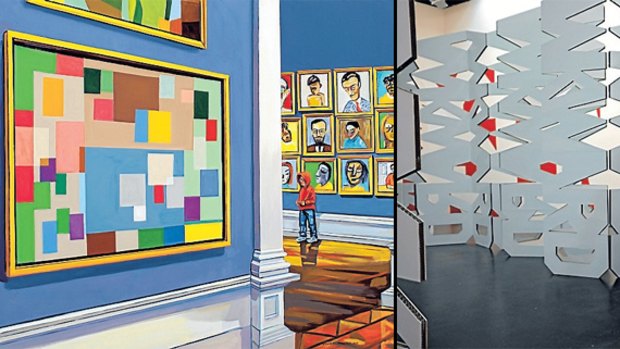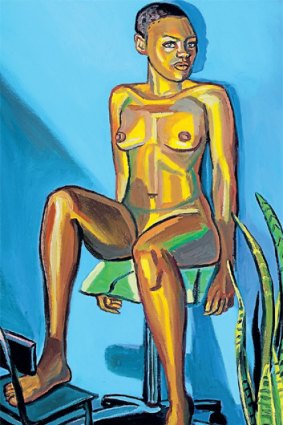LIVING FOR TODAY (ANOTHER HOMEWORK EXPERIMENT)
Rose Nolan, Margaret Lawrence Gallery, 40 Dodds Street, Southbank, until November 12
MAINLAND
Stewart Macfarlane, Australian Galleries, 35 Derby Street, Collingwood, until November 5
ROSE Nolan has erected a collapsible chapel at the Margaret Lawrence Gallery. A large screen blocks your access to the far room and forces you to walk a narrow passage.

Awkward spaces in art and experience are the subject of cardboard sculptures by Rose Nolan and paintings by Stewart Macfarlane (below).
Inside and outside are similarly hectic. On both sides of the zig-zag shrine, the wall is a concertina, without substance; and the panels themselves aren't complete: they are perforated, like a lattice that children might make by snipping chunks out of the edge of folded paper.
Your perception, already destabilised by so many angular wobbles, is further unsettled by the presence of a word, because a text is built into the screens that tickles your anxiety. In fact, the panels are nothing but a word, a very unassuring word, reiterated on every angle: the letters spell "awkward" in large overlapping block letters created by the cut-out shapes.

Stewart Macfarlane paints subjects that are too awkward for art.
Awkward and flimsy, like origami in cardboard, the sculpture relies on the rigidity of being bent. The screen is made of many layers, cut with precision. Tape is sandwiched inside the lamination, so the planes are connected by a fold. The line of weakness is paradoxically the source of strength for the structure: the folds, which are the floppy part, are the reason for the cardboard standing, because the adjacent planes keep one another stiff.
Awkwardly, I tried to imagine what the assembly would look like all stretched out, or alternatively how it would fit into the van when compressed. It's almost not there but then explodes into presence. Erected as a screen of multiple folds, the structure creates space within the gallery, remarkably, because it's really just an obstruction. There seems no end to the paradoxes.
All around Nolan's cumbersome monument, which is called An awkward screen, the wall spells out a further concept in abstract geometric painted shapes: A sense of something. This title reflects the awkward moment when we think of something new but cannot identify it with any certainty. It's just a sense of something. Though less architectonic, the angular letters on the wall add to the slightly jarring quality of the screen, reducing your sense of co-ordinates that a room normally gives you with its identifiable corners.
Nolan is far from the only artist to contemplate the awkwardness of experience and its translation into art. Even in stable, venerable media such as painting, the same challenge is present.
Stewart Macfarlane paints subjects that seem too awkward for art. The nude cast in contemporary scenic backdrops is bound to sit uneasily between a classical aesthetic and commercial fantasy, both of which have long been denounced as promoting the stereotype of woman as passive doll.
If anything Macfarlane hams up this discomfort, choosing young and beautiful models who gladly take on a provocative pose in some hotel or office environment. The works are theatrical rather than anti-feminist. They're candid portraits of male fantasy, which belong to a confessional genre of realism.
The only problem with this endgame with sex-ponies is that the awkwardness gets its revenge through the paint. Macfarlane admirably paints the flesh with plenty of colour, which he assigns to certain contours. His technique greatly enriches the presence of volumes. However, the forms in a body are extremely complicated and Macfarlane's schematic manner doesn't always respect the changes of curvature by according them a change in hue.
The confidence of the rendering is breathtaking but also slightly awkward, because the colour sometimes follows the tone rather than the plane. For all that, they are a perfect record of how to grapple with an awkward fantasy and maybe the project shouldn't be more elegant than it is.
robert.nelson@monash.edu